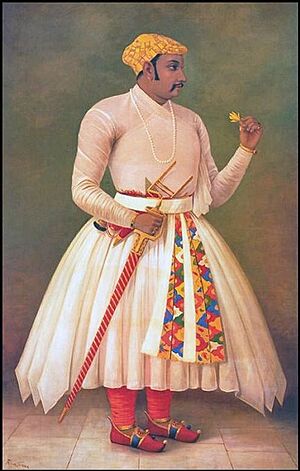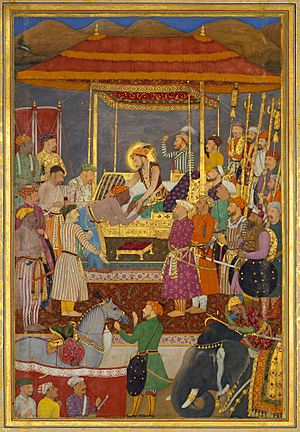Amar Singh I facts for kids
Quick facts for kids Maharana Amar Singh I |
|
|---|---|

Painting of Maharana Amar Singh I
|
|
| Maharana of Mewar | |
| Reign | January 19, 1597 – January 26, 1620 |
| Coronation | January 19, 1597 Udaipur |
| Predecessor | Maharana Pratap |
| Successor | Karan Singh II |
| Born | March 16, 1559 Chittor Fort, Mewar Rajputana |
| Died | 26 January 1620 (aged 60) Udaipur, Mewar Rajputana |
| Spouse | Rathorji Laksh Deiji of Idar
Solankiniji Manbhawat Deiji of Virpur/Lunawada in Gujarat Tomarji Shyam Deiji of Gwalior Rathorji Ram Deiji of Marwar Jhaliji Raj Deiji of Delwara in Mewar Rathorji Satyabhama Deiji of Chavand in Mewar Hadiji Manbhawan Deiji of Bundi Rathorji Rukhmawat Deiji of Siwana in Marwar |
| Issue | Karan Singh II
Bhim Singh Suraj Mal Arjun Singh Ratan Singh Bagh Singh Kesar Kanwarji m.to Rao Surtan Singh I of Sirohi |
| House | Sisodia |
| Father | Maharana Pratap |
| Mother | Ajabde Punwar |
| Religion | Hinduism |
| Military career | |
| Battles/wars |
|
Maharana Amar Singh I was a brave ruler of the Mewar Kingdom. He was born on March 16, 1559, and ruled from January 19, 1597, until his death on January 26, 1620. He was the eldest son of the famous Maharana Pratap I and became the 14th Rana of Mewar.
Contents
Early Life and Rule
Amar Singh I was born in the old fort of Chittor on March 16, 1559. His mother was Ajabde Punwar, the chief queen of Maharana Pratap I. Interestingly, the new capital city of Udaipur was started by his grandfather, Udai Singh II, in the same year Amar Singh was born. When his father, Maharana Pratap, passed away on January 19, 1597, Amar Singh took over as the ruler of Mewar. He continued to lead his kingdom until his own death in 1620.
Battles with the Mughals
By the end of his father's rule, much of Mewar had been won back from the Mughals. This included 36 outposts, but Chittor and Mandalgarh remained under Mughal control. Amar Singh I faced many challenges from the powerful Mughal Empire throughout his reign.
Fighting Emperor Akbar
After Maharana Pratap's death, Emperor Akbar sent a large army to Mewar. This army was led by Prince Salim (who later became Emperor Jahangir). Following his father's strategy, Rana Amar Singh and his forces hid in the hilly areas of western Mewar. From there, they launched surprise attacks on Mughal camps.
One notable event was when Sultan Khan Ghori, a Mughal commander, was attacked and killed. Prince Salim then came to Udaipur and ordered his commanders to fight harder against Mewar. In response, Maharana Amar Singh attacked near Malpura, taking over several towns. He also raided Mughal outposts at night. The Mughal campaign didn't achieve much, as their main commander, Man Singh, was called away to Bengal. Towards the end of his life, Akbar even tried to put another prince, Sagar, on the throne of Chittor, but he died before this plan could happen.
Fighting Emperor Jahangir
Soon after becoming emperor in 1606, Jahangir sent a large army of 20,000 horsemen to attack Mewar. Amar Singh bravely defended his land. In one battle, he personally killed the Mughal commander Sultan Khan and his horse with a spear.
In 1608, another Mughal army, led by Mahabat Khan, was sent to Mewar. But this army was defeated and had to retreat because of constant attacks from Rajput forces. In 1609, Abdullah Khan took over the Mughal command. He had some early success, forcing Amar Singh to leave his capital at Chavand. However, Abdullah Khan was eventually defeated by Mewari forces at the Battle of Ranakpur in 1611, making his mission a failure.
After more Mughal commanders failed, Jahangir himself came to Rajputana in 1613 to oversee the campaign. His son, Khurram, led the fighting on the ground. The Rajputs used the hilly terrain to their advantage, making it hard for the Mughals to enter. But in 1614, the Mughals finally managed to get into the hills and set up their camps. After many attempts, a peace agreement was finally reached in 1615 when Amar Singh agreed to meet with Prince Khurram.
The Peace Treaty
After many years of battles, Mewar had suffered greatly. Its finances were low, and many soldiers had been lost. Because of this, Amar Singh decided it was time to talk peace with the Mughals. He was advised by his council and his grandmother, Jaiwanta Bai. In 1615, he signed a treaty with Shah Jahan, who was representing Emperor Jahangir.
The treaty had several important points:
- The ruler of Mewar would not have to go to the Mughal court in person. Instead, a family member would represent him and serve the Emperor.
- The Ranas of Mewar would not marry into the Mughal royal family.
- Mewar would provide 1,500 horsemen to serve the Mughals.
- Chittor and other areas of Mewar that the Mughals had taken would be given back to the Rana. However, the strong Chittor Fort could never be repaired. This was because the Mughals feared it could be used in future rebellions.
- The Rana would be given a high rank within the Mughal system.
- The rulers of Dungarpur and Banswara, who had become independent, would once again become Mewar's vassals and pay tribute to the Rana.
Later, when Amar Singh met Jahangir in Ajmer, he was welcomed warmly. The areas around Chittor, including the fort, were given back to Mewar as a sign of goodwill. However, Udaipur remained the capital of Mewar.
Legacy and Death
Maharana Amar Singh I was known for his bravery, leadership, and kindness. He fought bravely against the Mughals, earning him the title 'Chakraveer' (a great warrior). He also supported scholars, and a book called Amara-bhushana was written during his time.
It is said that Amar Singh felt sad about having to sign the treaty with the Mughals. Because of this, he spent his last years in private, letting his son, Karan Singh II, handle the kingdom's affairs. He passed away on January 26, 1620.
See also
- Chundawat
- Shaktawat


